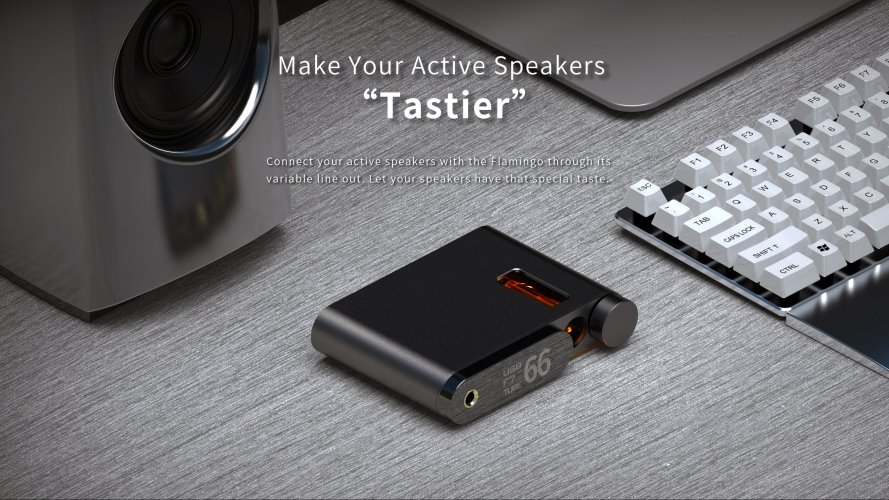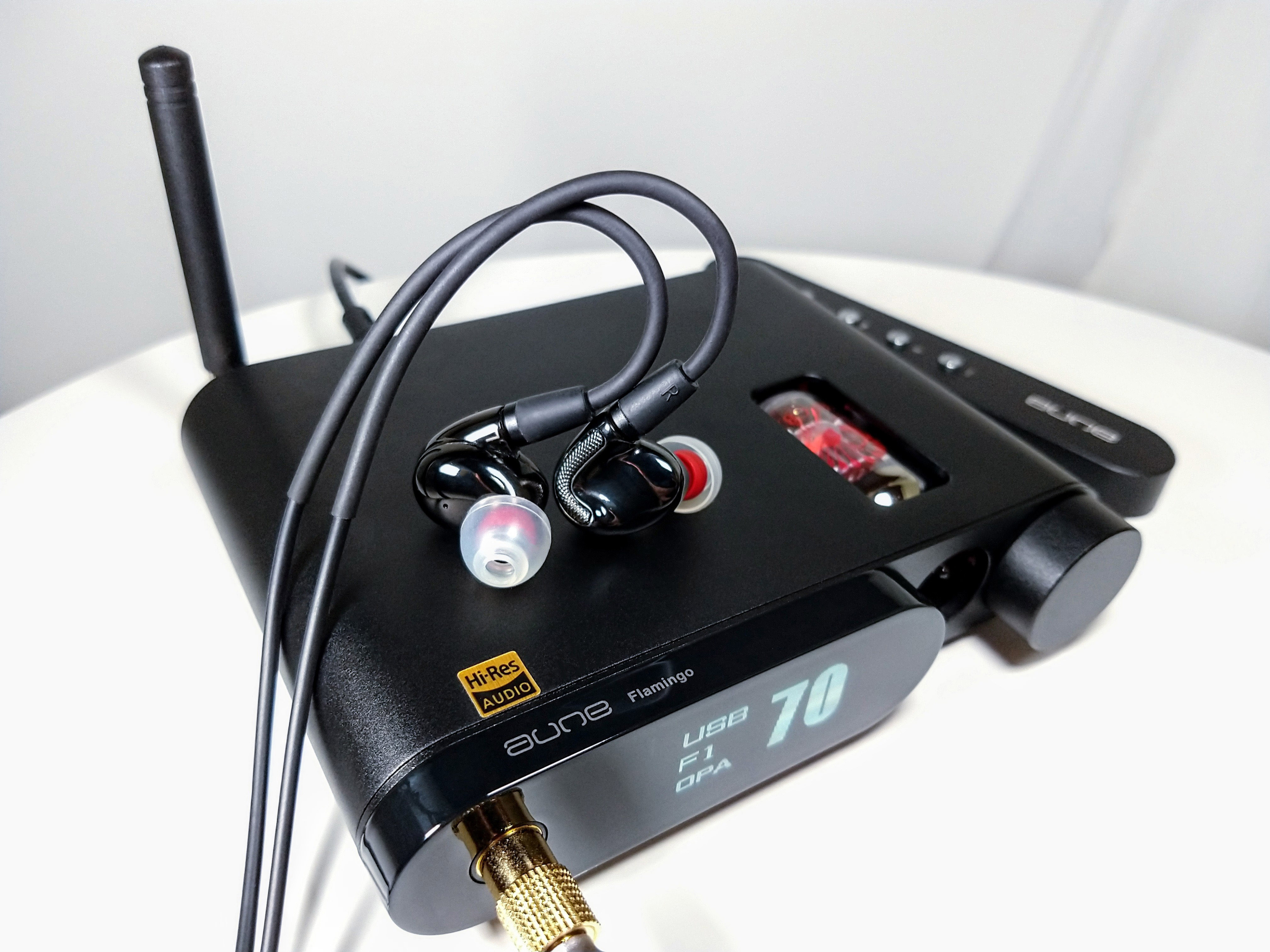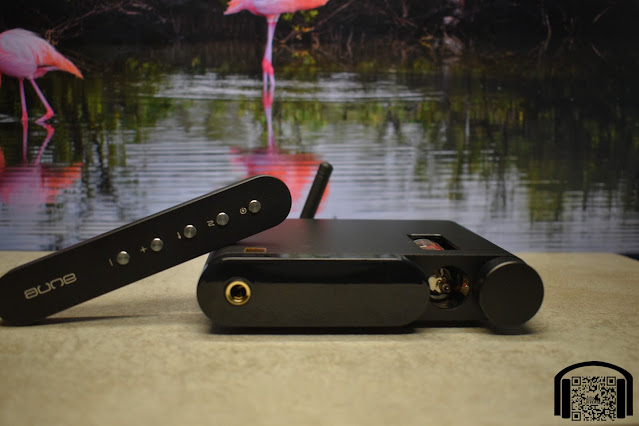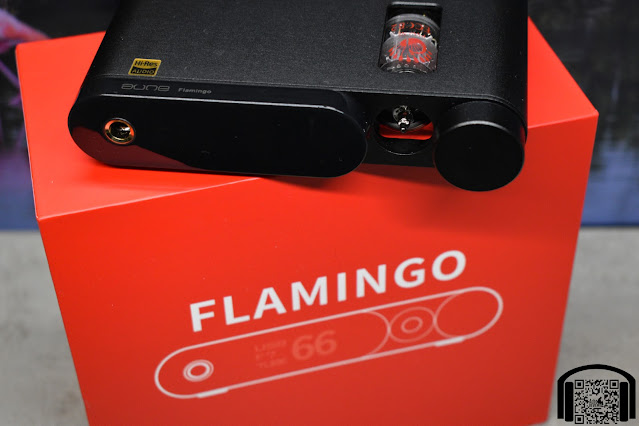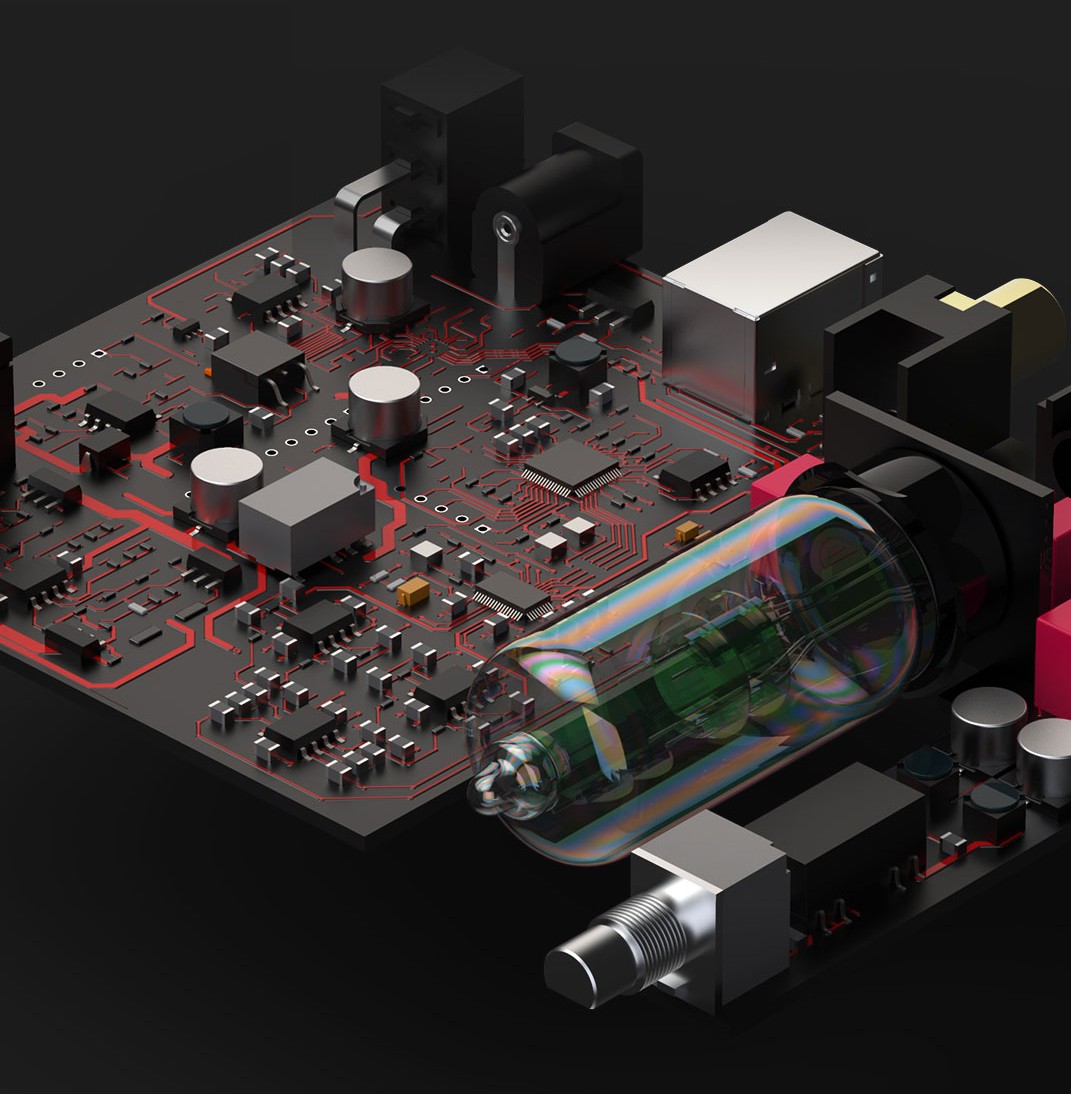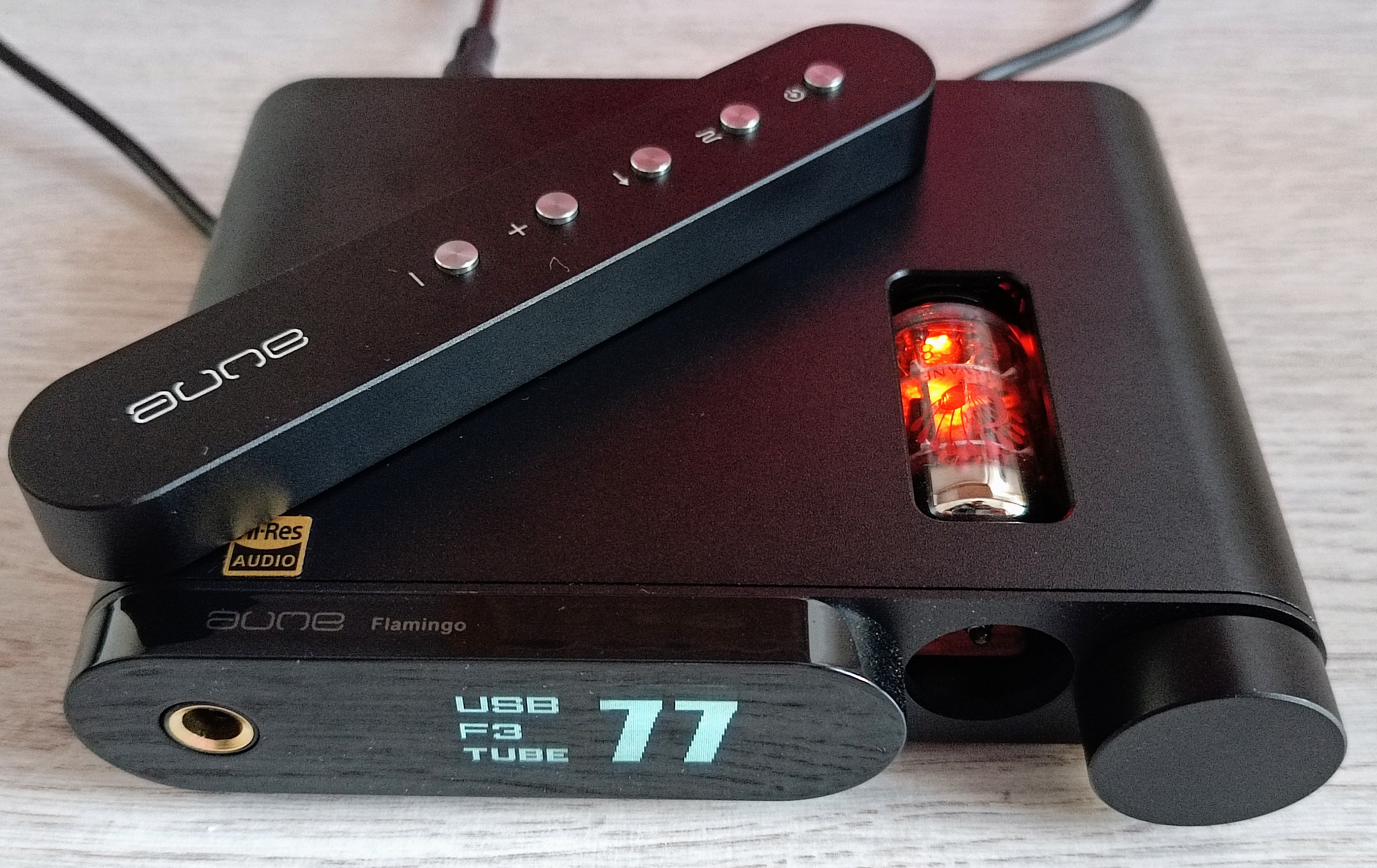My friends, today I have here a very special product for evaluation, the AUNE FLAMINGO, which is a desktop DAC/AMP with a vacuum tube system. The product is available in two versions, with Bluetooth or without Bluetooth. The Flamingo also has the option of using a remote control, but only the bluetooth version comes with the remote control included. It’s possible to purchase the remote control additionally. The unit I have here is the full version (with bluetooth and remote control).
(this is just a DAC/Bluetooth, that is, it doesn’t have the amplifier part).
– Suports: USB: PCM 32-Bit/768kHz, DSD512 – Coaxial: 24-Bit/384kHz, DoP128 – Bluetooth: 24-Bit/96kHz
A product with many details and features, the review will be a little big, there’s no way. Let’s start by talking about design and construction. Aesthetically the equipment is very beautiful, perhaps one of the most beautiful DAC/AMPs available on the market nowadays. This for me is also the most beautiful product that the company has made (so far). I like minimalism and products with more sober colors, like black, dark gray, etc., so my expectations for this product are very high.
It is undeniable that the great attraction of the Flamingo is the vacuum tube in a horizontal position, it brings that feeling between the modern and the retro, between the digital and the analogue… even because the product isn’t just a tube amplifier, it also has an internal operational amplifier system (OP-AMP) in solid state. According to the company, the tube cannot be replaced. The product has a display (screen) on the front that also generates this contrast between the digital and the analog. The screen shows the volume level in a very visible way, as well as other information such as which filter, which input, and which mode (tube or OP-AMP) is being used. I thought the display lacked more detail information like sampling rate, file type, that sort of thing.
The product is all made of metal – I didn’t get the information on which metal alloy was used. Although small in size, in terms of weight, it was not so “discreet”, according to the company, it weighs approximately 1Kg. I think this isn’t a problem for a product intended for use on desks, in fact this is even good because it generates more stability for the equipment on the desk. Unfortunately, the weight it has still doesn’t make it stand still when removing or inserting the earphone plug, it’s necessary to hold it with one hand so that the product doesn’t slide across the desk.
A curiosity. After you turn on the product, it takes about 4-5 seconds until be able to work completely. It’s easy to know when it’s ready because it makes a “click” sound. Taking advantage of this question of turning on the product, the Flamingo has an on/off button on the back of the equipment. This for me was great in the product, something I missed on the
iFi ZEN Air DAC, I already miss an on/off button on dongles, imagine on desktop equipment, it’s essential.
Potentiometer (or volume knob). The volume knob is infinity style, it means you can rotate it either way and it will keep going. The Flamingo has a scale of 00 to 99 steps of volume, with a progression of 1 in 1 step. With each step you take, the knob generates a “click”, that is, you can hear the command being executed very audibly, but not loudly. In my opinion, this sound didn’t bother me, but anyone who has a problem with this, here’s my warn.
In addition to having the function of controlling the volume, the volume knob makes the change from the OP-AMP mode to the Tube mode if you double press it. It’s also through it that you do the menu operations, such as changing the signal input (USB, Coaxial, Bluetooth), changing the filters.
Flamingo supports PCM files up to 32bit/768kHz, and DSD files up to DSD512. It isn’t able to run MQA files. For me, this question of MQA and other Hi-Res files made no difference, since I only use 16bit/44.1/48kHz FLAC files and some more common streaming services, such as Spotify and Deezer in my daily life. However, I find it interesting that the product offers the greatest possible file support.
Bluetooth. The Flamingo bluetooth edition has the feature of connecting an antenna and the equipment becoming a bluetooth receiver, that is, it receives the signal from some device and you listen to your music with the earphones plugged into it. For those who don’t want the product to use an USB cable connection, bluetooth is a good alternative (one less cable on the desk). From what I saw in the specs, the bit depth and sampling rate for the bluetooth signal is restricted to 24bit/96kHz. I used my smartphone as a signal transmitter and the Flamingo paired up easily on the LDAC. Here’s a picture of the Android:
click here!
To do the sound evaluation I used the USB-A to USB-B connection. The product was immediately recognized as soon as I connected it to my computer, I didn’t need to install any drivers for it to work in Windows10 (Plug & Play). It has already been in 100% on Windows, so you need to be a little careful when playing the song. The product has an analog RCA output on the back that can be used as a DAC/Pre-AMP for an amplifier or for active speakers. It also has an audio input via coaxial cable.
Something I missed about this DAC/AMP was the lack of the 3.5mm output and/or even the balanced 4.4mm output. It only has a 6.35mm output, which is easier to find on headphones. I only use exclusively IEMs, so I need to keep an adapter always plugged into the output of the product. The lack of the Pentaconn output affected me too, I have IEM with a 4.4mm cable, so I need to use 2 adapters to connect the earphone. For me, the less adapter the better, there are people who don’t care about that.
Heating. Here we have perhaps the point that made me most apprehensive of this product. The product heats up a lot the surface, I thought its temperature was quite high, regardless of whether it was running by the tube system or by the OP-AMP. And so, you don’t even need to spend a long time using, shortly after turn on it starts to heat up, about 15 minutes. Okay, this product isn’t a dongle, I won’t keep it in my hands or in a shorts pocket, for example, but I’m a little worried about the product getting so hot in such a short time. It really got really hot, I’ve never seen anything like that.
I don’t have much experience with desktop DAC/AMPs, this is the second one I’ve tested, and the first one –
iFi ZEN Air DAC – didn’t have this overheating problem. Here, obviously, this issue is related to the vacuum tube system, heating is part of the process of using the valve, but I didn’t imagine it would be like this, to this degree. Another thing, the Flamingo only turns on if it is connected to the power source, that is, it doesn’t work only with the USB-B connection, something that in the iFi ZEN Air DAC it only needed the USB cable to pass data and energy.
Remote Control. The Flamingo bluetooth edition has a remote control included. The control is very simple, I found the design even a bit “no salt”, but I understand that it matches with the format of the product. You can find a guide to the functions
here in the user manual. It comes with a Torx T1 key to remove the battery (I didn’t open the product though). I even tried opening the control, but it looks like the screw would be better to remove with a Torx T2 key (I think).
Accessories. The product has a very interesting kit (speaking of the version I’m reviewing), honestly I have nothing to complain about what came included. Comes with the bluetooth antenna, a USB-A to USB-B cable, a USB-C to USB-B adapter, a 3.5mm to 6.35mm adapter, a remote control, a key to open the remote control, three plastic caps to close it the RCA and Coaxial connections, and also came a radio antenna (I believe it is, but I didn’t even test this function). Speaking specifically of the included cable, I thought it was great, it is 150cm long, which allows me to place the DAC/AMP on any side of the computer I need. I only don’t prefer this USB type B input, I think USB type A is more safe.
PS: regarding the power supply, you must be aware that the sockets fit can vary from region to region of the world, so you need to establish some contact with the seller beforehand so that you don’t acquire a different socket pattern. Here in Brazil, the European standard (EU) was compatible (two round pin plug).
SOUND ASPECTS:
It must be remembered that this analysis is subjective, based on my experience with the product and also on the synergy with the other equipment I used here. I also already inform you that the more objectivist part of the hobby is not really my beach, so it may be that some information can be limited, I don’t have much knowledge about the technical side of this type of product.
Here again in my audio hobby journey I come across something different. Dongle goes in and dongle goes out and sometimes I heard very similar or equal sounds, however with the AUNE Flamingo the situation was different. Here, as at the beginning of my journey, I realized once again that the power of amplification can change the sound of some earphones. In fact, the Flamingo isn’t a DAC/AMP that powerful, according to the company it delivers 300mW at 32 Ohms, there are equipment on the market that deliver well over 1W, but what I heard here with it was different from anything I’ve heard before listened with the dongles I was able to test. I explain more in the next paragraph.
So, what happened here at Flamingo together with the company’s own IEM – the AUNE Jasper – was that the sound of the IEM opened up in a very expressive way, the bass, the spatiality, everything became wide. I had never heard this IEM the way I heard it here now. The sound became fuller, with more texture in the bass, even more physically, and with a greater spatial filling. It was certainly a very interesting experience, listening to the same IEM that I already knew, but in a different way. I could say that, from the sound I had heard before to now, the sound became warmer.
During my tests here, the audio quality of the AUNE Flamingo was excellent, for me, the equipment delivers a lot of transparency, definition and no coloration. According to the company, the product is implemented with the DAC chip from ESS, model ES9038Q2M, in addition to other high quality components. I didn’t notice any noise, distortion or strange sound during the time that I was testing the product. The Flamingo follows the quality of the other DAC/AMPs that I have currently tested.
OP-AMP and tube mode. Look, honestly, I didn’t feel any difference between the OP-AMP mode and Tube mode, I made the changes from one mode to the other several times looking for the changes but in fact I particularly couldn’t notice. And so, I don’t think the Flamingo’s sound is more warmer than the other DAC/AMPs I’ve tested just because of the tube, no, for me that sound comes from the power of amplification that the equipment offers (in my opinion).
About the bluetooth, my position is that I didn’t get any sound detriment in relation to the wired connection (USB-B), for me, the sound was presented in the very same way as if I were listening through the cable. I used the LDAC codec, it already handles what I have here from my music library.
Filters. Another resource that Flamingo brings are these sound filters, which are 7 types in all: Apodizing fast, Fast linear, Slow linear, Fast minimum, Slow minimum, Corrected minimum, and Brick wall. Here again I can honestly say that I couldn’t hear any difference between the 7 filters… nothing different for me from one to the other.
Amplification. Here yes I felt a very interesting difference. I did a test with the Tin HiFi P1 and I thought that the Flamingo was able to push this IEM correctly. The interesting thing here is that we don’t have a gain knob, the sound expands as you increase the volume on the potentiometer, so you need to reach volume 80 for the sound to start to stand out. In Tin P1 for example, it only starts to get interesting from 85 to above. There’s a big difference when the volume is below 75, it gets really low. Maybe with a more sensitive IEM this number could be lower, however, with Jasper, it was 70-75-80 volume for it to be ideal (and I listen to music at a medium to low volume). I put the P1 on vol. max. and the sound was really loud, just to test if it would distort the sound, and luckily it didn’t distort, but it’s kind of unthinkable to hear any IEM at that volume.
Comparative. Nowadays I’ve been using the Questyle M15 DAC/AMP Dongle to review the products, it’s a portable device, so this comparison might not be very fair. My thoughts on the “warmer” sound of the Flamingo is precisely in comparison with the sound I hear today with the M15, from what I could see, the Flamingo manages to deliver more full bass than the M15. In terms of spatiality (or soundstage), the Flamingo also manages to deliver a much wide feel to the songs than the M15. With this extra presence in the lower regions, the upper mids of the Jasper ended up being more “balanced”, that is, they had a feeling of being lower, so in contrast to the M15, the Questyle dongle ended up with a “bright/cold” sound compared to the Flamingo.
Thank you so much for being here!
Consider follow us on
Facebook and
Instagram to get all the news!










